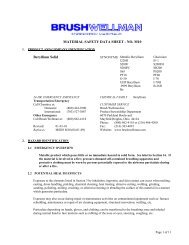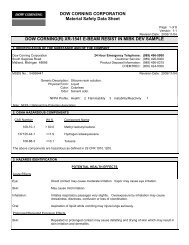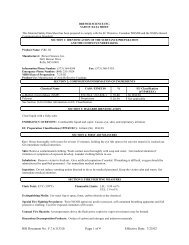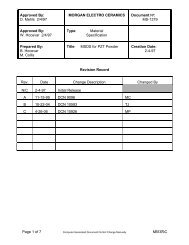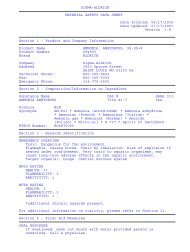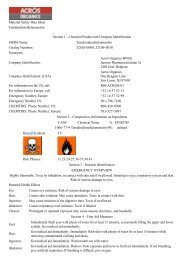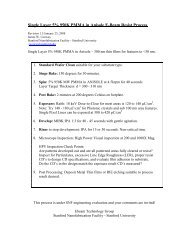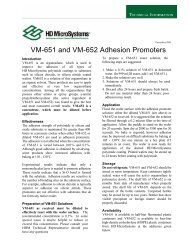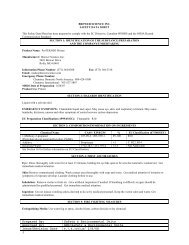Radiation tolerant sensors for the ATLAS pixel detector
Radiation tolerant sensors for the ATLAS pixel detector
Radiation tolerant sensors for the ATLAS pixel detector
Create successful ePaper yourself
Turn your PDF publications into a flip-book with our unique Google optimized e-Paper software.
and <strong>the</strong> 5 disks in each <strong>for</strong>ward direction. The<br />
modules <strong>for</strong> <strong>the</strong> B-layer are needed about 2 years<br />
later allowing a separate production and <strong>the</strong> use of<br />
<strong>the</strong> MCMD-technology, which will be optimized<br />
according to <strong>the</strong> special B-layer requirements, e.g.<br />
300 mm long cells. One important option is to have<br />
equal-sized <strong>pixel</strong> cells all over <strong>the</strong> sensor without<br />
elongated and ganged <strong>pixel</strong> as <strong>the</strong> cell geometry is<br />
not dictated by <strong>the</strong> read-out chip and also <strong>the</strong><br />
implementation ofbricked <strong>pixel</strong>s would easily be<br />
possible without any additional cross-talk caused<br />
by routing in one metal layer. These will improve<br />
<strong>the</strong> spatial resolution in this important layer <strong>for</strong><br />
<strong>the</strong> impact parameter measurement and <strong>the</strong><br />
b-tagging. There<strong>for</strong>e, <strong>the</strong> starting sensor wafer<br />
production will be <strong>for</strong> tiles <strong>for</strong> <strong>the</strong> outer modules<br />
which will be built with a flex hybrid. The wafer<br />
layout has been finalized according to <strong>the</strong> results<br />
of<strong>the</strong> prototype studies. The design of<strong>the</strong> <strong>pixel</strong><br />
cells is shown in Fig. 7, with <strong>the</strong> bias-grid structure<br />
in <strong>the</strong> middle and <strong>the</strong> passivation opening <strong>for</strong><br />
bump bonding on <strong>the</strong> o<strong>the</strong>r side ofeach <strong>pixel</strong>.<br />
Besides three tiles <strong>for</strong> <strong>the</strong> <strong>ATLAS</strong> <strong>pixel</strong> <strong>detector</strong><br />
modules, <strong>the</strong> wafer will contain six single chip<br />
devices and a number oftest structures <strong>for</strong> quality<br />
control. According to <strong>the</strong> Quality Assurance plan,<br />
part of<strong>the</strong> control measurement will have already<br />
been per<strong>for</strong>med by <strong>the</strong> vendors, but <strong>the</strong>se measurements<br />
and additional tests will be per<strong>for</strong>med<br />
by <strong>the</strong> <strong>ATLAS</strong> institutes.<br />
6. Conclusions<br />
R. Wunstorf / Nuclear Instruments and Methods in Physics Research A466 (2001) 327–334 333<br />
With <strong>the</strong> knowledge of<strong>the</strong> radiation effects in<br />
silicon <strong>detector</strong>s as a good starting point, <strong>the</strong><br />
Fig. 7. Design of<strong>the</strong> <strong>pixel</strong> sensor cell <strong>for</strong> <strong>the</strong> <strong>ATLAS</strong> <strong>pixel</strong> <strong>detector</strong>.<br />
<strong>ATLAS</strong> <strong>pixel</strong> collaboration began in 1996 to<br />
develop silicon <strong>pixel</strong> <strong>sensors</strong> capable ofsurviving<br />
<strong>the</strong> harsh radiation environment at <strong>the</strong> LHC. To<br />
reach this challenging goal, a dual-track strategy<br />
was followed. Besides <strong>the</strong> studies concerning <strong>the</strong><br />
sensor design and prototyping within <strong>the</strong> <strong>ATLAS</strong><br />
<strong>pixel</strong> collaboration, <strong>the</strong> investigations of<strong>the</strong><br />
radiation hardness ofsilicon were done within<br />
<strong>the</strong> ROSE collaboration. The result is an n + –in–n<br />
<strong>pixel</strong> sensor with moderated p-spray using oxygen<br />
diffused silicon. Indispensable to <strong>the</strong> quality<br />
control during production is <strong>the</strong> implemented bias<br />
grid, which enables measurements of<strong>the</strong> I2V<br />
characteristic with two contacts and prevents<br />
problems due to missing bumps during operation.<br />
Acknowledgements<br />
These important results <strong>for</strong> <strong>the</strong> <strong>ATLAS</strong> Experiment<br />
could not have been achieved without <strong>the</strong><br />
considerable engagement of<strong>the</strong> members of<strong>the</strong><br />
<strong>ATLAS</strong> Pixel Collaboration and <strong>the</strong> ROSE<br />
collaboration and <strong>the</strong>ir cooperation. There<strong>for</strong>e,<br />
<strong>the</strong> acknowledgement goes to all who participated<br />
in <strong>the</strong> sensor design, <strong>the</strong> sensor measurements, <strong>the</strong><br />
irradiations, <strong>the</strong> testbeam runs and <strong>the</strong> logistics,<br />
sending <strong>the</strong> <strong>sensors</strong> on time to <strong>the</strong> different places.<br />
References<br />
[1] <strong>ATLAS</strong> Collaboration, <strong>ATLAS</strong> Pixel Detector Technical<br />
Design Report, CERN/LHCC/98-13, Geneva, 1998.<br />
[2] <strong>ATLAS</strong> Collaboration, <strong>ATLAS</strong> Inner Detector Technical<br />
Design Report, CERN/LHCC/97-16 and CERN/LHCC/<br />
97-17, Geneva, 1997.



